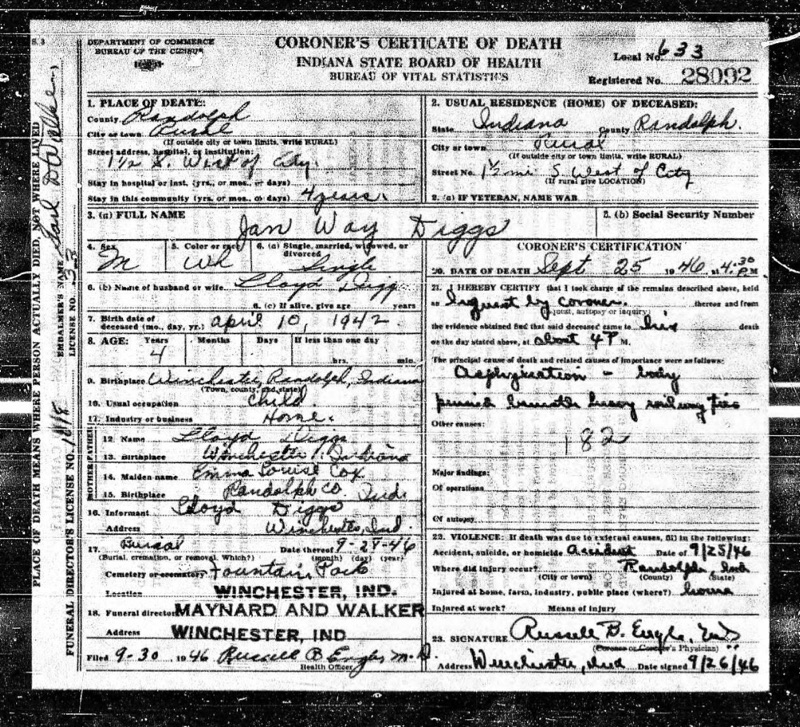Winchester News-Gazette, 1973.
Alma Meier Price, who lives just across Pearl street south from the Goodrich elevator now being demolished at Winchester, has some reminiscences about the area (the Meier/Price brick house is still standing on the southeast corner of N. Meridian and Pearl, 2019.)
"With the passing of the Goodrich elevator my memory goes back to the time before it existed-the early 1890's."
 |
| Feed sack on display in The Annex at The Museum for RCHS, Inc., Winchester, Indiana. |
"On Pearl street in Winchester facing south, Stephen Clevenger owned and operated a coal yard-also sold a great deal of lime. He delivered by horse and wagon. A building east of this-also a one story place-housed a gun and locksmith shop owned by Wesley Ginger, who lived nearby on North Main street, his granddaughter is still living. She is Mrs. Arlene Browne Cheney Hubbard now of Cincinnati, Ohio. Then directly east of the gun shop was a blacksmith shop. This was a busy place. Then east of this and on Main street, a hay shed began business. This was owned by the late Jay Goodrich."
In summertime, Pearl street on many days was a busy street. Roving gypsies would pass through town and stop for hay. Also to have their horses shod at Mr. Shaver's shop and their guns repaired at Mr. Gingers. They spent the day in Winchester. The women would go from door to door to entice the citizens to have their fortunes told. The women were gaily dressed and wore gay head-dresses and many, many beads around their necks: also many bracelets. Since they were a roving group of people, they were not very cleanly clothed. Some merchants locked their doors because the gypsies were considered to be shoplifters. Children of the neighborhood would gather at a distance to see the gypsies, who usually bought staples at the groceries and bakeries located nearby and eat in their wagons. Gypsies usually had a goodly number of children with them. Their children learned the tricks at an early age.
On the southwest corner of Main and Pearl streets stood a pretentious 2-story hotel. It served the traveling public, or traveling men who brought their trunks filled with the latest merchandise which they sold or would take orders from the uptown business places. At this period of time all travel at distances was by railroads. This hotel was called the Upper Irvin House, owned and operated by Sylvester Irvin: very fine foods were served also in a large carpeted dining room.
Across east from the Irvin house on Main street, a Mr. George G. Keller owned a grocery store. He owned the two-story building which still stands and is in good condition. (Vacant in 2018, was Chuck Reeve's Café for many years.) Mr. Keller later took his son in as partner. In a few years the elder Mr. Keller retired and sold half the business to his son-in-law John C. Miers, who had learned the baking trade in Cincinnati, so a bakery room was built on the back of the grocery to take care of the expanding business. In these years Winchester had at least 4 bakeries, bread selling at 10 cents per loaf or 3 for 25 cents. Mr. Keller then sold out to Mr. Meier who owned the grocery for 20 years, selling out to Mr. Hugh Hill about the year 1910.
There is a 3-cornered lot at the present time on N. Meridian and West Pearl streets. (Andy Reed's transmission shop 2018) In the early 1870's an elevator stood there and did a flourishing business.
The railroad constructed a 'y' so as to connect the CCC & St. Louis railroad (The Big 4) with the Grand Rapids & Indiana so that grains could be shipped on either railroad. This 'y' still can be used. A Mr. Joseph Bishop owned the elevator, which was torn down in the early 1900's.
The Solomon Yunkers lived in the red brick house across south of the elevator. A real-life story, told in connection with the young Yunker girls, is that one winter night they watched the elevator being robbed. They were awakened by noises as the Yunker's horse had been turned loose by the thieves when they broke into the Yunker barn where they stole carriage blankets. They used these to deaden the sound when they blew the safe at the elevator. A usable pump and well stood in front of the elevator so they used this to wet down the blankets which were then laid over the safe.
"This all took place before telephones were around here and I am not sure if there were police. This occurred before I was born."
Want to learn more?
Visit The Museum.
Hours vary with volunteer availability. Check the website or Facebook for current open to the public hours or call/message/email to arrange an appointment.
Facebook group: Randolph County Indiana Historical and Genealogical Society
Visit the website.
Here is a link to the cemetery database. https://rchsmuseum.org/cemeteries-database
Follow the blog.
Scroll to the right or below the article to click "FOLLOW" to get email updates as soon as a blog is uploaded. This is a great feature to share with family and friends who are not active on social media.



.jpeg)

No comments:
Post a Comment